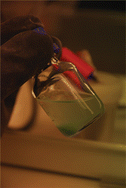|
Even 70 years after its discovery, the behaviour of plutonium still remains something of an enigma. Now Swedish researchers have discovered that plutonium colloids shrink with age becoming very small (3–4 atoms) with a shortening of the average Pu–O bond and Pu⋯Pu distances, consistent with partial oxidation having occurred. Two types of colloidal materials were studied: high-fired crystalline PuO2, and freshly prepared Pu(IV) colloids. The structures of both types were determined by EXAFS at the beginning of the experiment and after controlled aging of up to five years. The results show that even freshly prepared Pu(IV) colloids are polynuclear nano clusters with PuO2 structure, bringing new insight into the evolution of plutonium with time. |
The structure of plutonium(IV) oxide as hydrolysed clusters in aqueous suspensions
Christian Ekberg, Kristian Larsson, Gunnar Skarnemark, Arvid Ödegaard-Jensen and Ingmar Persson
Dalton Trans., 2013, Advance Article
DOI: 10.1039/C2DT32185H
Other Dalton papers by the same author are:
Crystal structure of [Eu(CyMe4-BTBP)2κ2O,O‘-(NO3)](NO3)2·n-C8H17OH and its structure in 1-octanol solution
Daniel Lundberg, Ingmar Persson and Christian Ekberg
Dalton Trans., 2013, Advance Article
DOI: 10.1039/C2DT32317F, Communication
Radiolysis of solvents containing C5-BTBP: identification of degradation products and their dependence on absorbed dose and dose rate
Anna Fermvik, Laurence Berthon, Christian Ekberg, Sofie Englund, Teodora Retegan and Nicole Zorz
Dalton Trans., 2009, 6421-6430
DOI: 10.1039/B907084B, Paper











